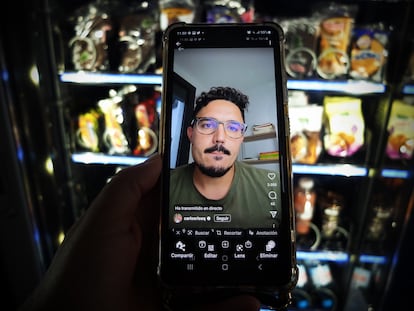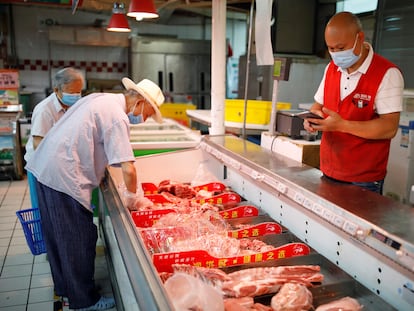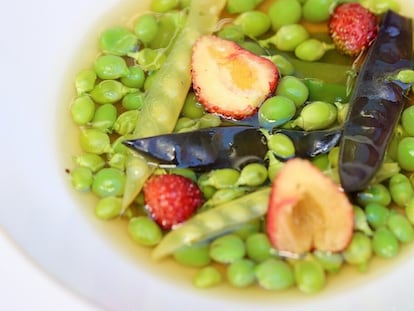Carlos Ríos: The rise and fall of the nutritionist who invented ‘realfooding’
The influencer created a huge following with a tale about food that pitted good and evil. After gaining millions of fans by criticizing processed products, he now sells them in supermarkets

Like many gurus before him, Carlos Ríos, a 31-year-old from Huelva in southern Spain, won his iconic status in the world of nutrition with predictions of doom. The signs of an apocalypse were everywhere: on supermarket shelves, billboards and vending machines. He flagged up the immense power of the food industry that would go to any lengths to ensnare us with harmful products in order to feed the insatiable appetite of its executives and shareholders. “Ultra-processed foods are slowly killing us because people consume too much of them and don’t know what’s in them,” he said in an interview in 2019.
In 2017, he included the media among those propagating the idea that “there are no good or bad foods,” warning that ultra-processed products should not be promoted “even in moderation” while pointing out that the discourse diminishing the perception of the risks of processed products is put out there to increase sales.
The apocalypse was near, but not inevitable. On social media, Ríos promised to open our eyes, offering himself as a guide to help distinguish real food from processed products and encouraging us to participate in his crusade by joining the realfooder army made up of people who eat, well, “real food.” This army would be going into battle against those not yet enlightened – the fakefooders as he called those who continued to consume processed fare, as well as the big guns of the processed food industry who had created an illusion like that generated by the robots that enslave humanity in the 1999 cult movie The Matrix. This rhetoric helped him sell tens of thousands of books adorned with vegetables, not to mention an app with a bell pepper logo on it and more than a million downloads, and 1.5 million followers on Instagram.
Ríos’ radical discourse against the evil processed food industry paid off, and his movement mutated into a brand. The Realfooding label now covers processed products such as croissants, chocolate spread and ice cream. All these products, Ríos acknowledges, “should not replace real fresh food,” but, he says, his versions are less harmful than those already on the market. “What’s wrong with their existence?” he said when questioned by EL PAÍS.
Taking care of yourself
In his transition from staunch processed food critic to business partner, Ríos has demonstrated a firm grasp of the changing significance of food, especially for young people; a sound handling of social media, and great marketing skills. “We used to talk about food in terms of shortages, but now it has been integrated into our perception of wellness,” says Cecilia Díaz Méndez, a professor of sociology at Oviedo University in northern Spain who specializes in food. “Taking care of oneself through what we eat and physical exercise is a social value and a status symbol. Revolving around something young people deem important, the realfooder movement fosters a common identity for a generation with multiple identities looking for elements that allow it to position itself socially. Ríos’ way of communicating is very community-oriented, pitting the good guys against the bad, realfooders versus fakefooders, which reinforces identity. It has an underlying vision with the message that we live in a deceitful society due to hidden forces, and young people identify with the idea that life may not have the value it should.”
Díaz believes the message also resonates with a younger demographic because “they are the generation that has begun to lose a very solid food culture – like the Spanish food culture – which generated identity. Now, in the absence of that, they identify with messages like those offered by Ríos. The food problem is complex, it’s hard to understand, and Ríos is a good preacher; he gives you simple solutions to help clear up doubts when it comes to buying, winning him many followers.”
Íñigo Marauri, a researcher at the Basque Country University who has published a study analyzing Ríos’ communication strategies, says that the creator of realfooding “had a marketing objective from the start – to make a name for himself. He had a clear vision that the message is important, but how you convey that message is possibly even more so.”
Marauri agrees that the Manichean story of good and evil has been very effective, being a tale in which “there are good guys and bad guys and no grey areas, and in which the feeling of belonging to a community is created – the community of good.”
To achieve this goal, social media were fundamental, but Instagram had a special relevance. “On Instagram, information can be effectively and clearly transmitted visually so that not a lot of time or attention is demanded from followers,” Marauri explains. “It plays with simple infographics and colors to help us quickly identify the good side and the bad side. Ríos chooses Instagram because it is a platform that does not allow for debate. Its hallmark is a great unidirectionality disguised as bidirectionality. It seems to allow for a lot of dialogue, but that dialogue does not exist. Ríos left Twitter when he had 90,000 followers because it allows for discussion and, when certain contradictions began to appear in his messages, he started receiving very negative responses.”
With followers came power and business opportunities. And, as with many revolutionaries, the movement’s transformation into a brand came with a shift from purism to pragmatism. “I’m doing something that few others are doing,” Ríos pointed out. “Thanks to the support of my community, we can bring out products that can work, because products in this food system stay if they are tasty and profitable, and we also make them as healthy as possible: croissants with 100% whole wheat flour, ice cream with fewer calories and pizzas with wholesome ingredients.” In the long term, he suggests his strategy is to “take on the food industry titans and create a supermarket selling only healthy food.” To boost a healthy food industry, products can be added to the supermarket shelf that, by Ríos’ own admission, would be better consumed only very occasionally.
A croissant is a croissant and a soft drink, a soft drink; they are never going to be goodJuan Revenga, nutritionist
Juan Revenga is one of the many nutritionists outraged by the shift in Ríos’ s rhetoric. “Carlos Ríos has gone on a rant about certain multinationals such as Danone, with which he now collaborates,” he says. “Danone’s natural yogurt is very good, but the brand has custard and sugary milkshakes and its advertising is very questionable and always threatening to cross the red line.” Danone’s liquid yogurt with the Realfooding label, which is very similar in nutritional terms to the multinational’s traditional natural yogurts, carries a higher price tag: almost two euros more per kilo.
“All of us nutritionists make a living selling broccoli, mandarins and turbot, but Ríos could see that this niche was already occupied and offered little by way of economic return, so he moved on to something else,” says Revenga. “A croissant is a croissant and a soft drink, a soft drink; they will never be good and they do not have a place in healthy eating programs, just as cookies and ice cream don’t. If you want a croissant, pick the one you like the most, not the one with a label that misleads you. The less you eat of it, the better, but when you do enjoy it, don’t feel guilty about it.”
Revenga has put Ríos’ products to the test. After analyzing the products with the Realfooding seal in supermarkets, he concludes that most of them fall short. In a detailed blog post, he explains how according to the NOVA system, a tool with broad scientific consensus to measure processed foods, almost 60% of Realfooding products would be classed as ultra-processed, according to the World Health Organization’s criteria, while 73.7% could not be advertised to children because of their poor nutritional content. Rios’ brand comes out very well, however, on his own MyRealfood app. He admits his products are processed but he says they are good processed products.
Among the experts who are more forgiving of Ríos is Ana María Ruiz, from Barcelona’s Hospital Clinic, who recognizes his brand’s efforts to launch products such as “a cola soft drink, chocolate spread, cookies, croissants and ice cream with better quality ingredients and nutritional content, something that should be appreciated.” However, she also points out that “these are still foods that have no place in a healthy diet.”
Julia Díez, a professor at Alcalá de Henares University in central Spain, is rather more critical. She believes that, “beyond clear conflicts of interest and ethics, Ríos’ movement could become a public health issue” because the processed Realfooding products “promote something as being healthy that is obviously unhealthy.” In her opinion, gurus like Ríos “tend to make the individual responsible, and when you set such strict rules, people can end up blaming themselves for going out to dinner with friends. The changes have to be in society as a whole. The gurus are not discovering anything new; people don’t eat badly because they don’t know how to eat well, but because of the attractiveness of those foods or on account of their price. Watermelon is more expensive than chicken nuggets.”
Díez goes on to explain that, traditionally, the world of diets and nutrition fails to take into account the social aspect of food, although there are many nutritionists who are changing the discourse. “In the long term, interventions at the individual level don’t stick, and if you don’t change the context in which people live, they’re not going to,” she says.
Ríos agrees that to improve the nutrition of society as a whole, “it would be much more effective if there were public health policies such as taxes on ultra-processed foods and sugary drinks and subsidies for fruits and vegetables.”
Meanwhile, he believes there is an element of envy behind the attacks against him. “When you grow, your success does not go down well with fellow professionals, who have often been friends. The realfooding message hasn’t changed,” he says.
Ríos goes on to talk about getting people out of the Matrix, but, according to this analogy, he seems to have given a tool to the evil food industry to help them disguise their fake world as reality. In the film, a member of the resistance called Cypher who is tired of the hardships of the real world, betrays his friends in exchange for being reconnected to the fake world filled with pleasurable experiences. In a meeting with bad guy Agent Smith, he enjoys a steak that exists only in his head. “You know, I know this steak isn’t real: I know when I put it in my mouth the Matrix is telling my brain that it’s juicy and delicious. After nine years, you know what I realize? Ignorance is bliss.”
Ríos’ supposedly “healthy” processed foods may become a way of returning to the delights of the Matrix for many of the rescued fakefooders: tasting the forbidden foods while maintaining the illusion that they are eating healthy.
Tu suscripción se está usando en otro dispositivo
¿Quieres añadir otro usuario a tu suscripción?
Si continúas leyendo en este dispositivo, no se podrá leer en el otro.
FlechaTu suscripción se está usando en otro dispositivo y solo puedes acceder a EL PAÍS desde un dispositivo a la vez.
Si quieres compartir tu cuenta, cambia tu suscripción a la modalidad Premium, así podrás añadir otro usuario. Cada uno accederá con su propia cuenta de email, lo que os permitirá personalizar vuestra experiencia en EL PAÍS.
¿Tienes una suscripción de empresa? Accede aquí para contratar más cuentas.
En el caso de no saber quién está usando tu cuenta, te recomendamos cambiar tu contraseña aquí.
Si decides continuar compartiendo tu cuenta, este mensaje se mostrará en tu dispositivo y en el de la otra persona que está usando tu cuenta de forma indefinida, afectando a tu experiencia de lectura. Puedes consultar aquí los términos y condiciones de la suscripción digital.
More information
Últimas noticias
Welcome to the post-religion era: The idea of Christianity as the absolute truth has become obsolete
‘I thought you would like it’: The risky sexual practice popularized by TV shows and TikTok
The digitalization of tourism: ‘They promise experiences and gave us the worst possible one’
Mexican peso defies uncertainty with forecasts of a new period of stability in 2026
Most viewed
- Sinaloa Cartel war is taking its toll on Los Chapitos
- Oona Chaplin: ‘I told James Cameron that I was living in a treehouse and starting a permaculture project with a friend’
- Reinhard Genzel, Nobel laureate in physics: ‘One-minute videos will never give you the truth’
- Why the price of coffee has skyrocketed: from Brazilian plantations to specialty coffee houses
- Silver prices are going crazy: This is what’s fueling the rally











































